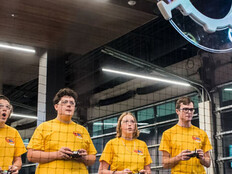Do Natural User Interfaces Have a Place in Schools?
As technology manufacturers design the latest gadgets to control televisions, video game systems and even computers, many find inspiration in movies such as Minority Report. Gesture-based interfaces, sensors that register all types of user and environmental inputs, and next-generation voice-recognition tools offer a new breed of human/computer interaction.
Cameron Evans, national technology officer for Microsoft Education, characterizes Microsoft Kinect — a motion-sensing input device for the Xbox 360 console and for Windows PCs — and other natural user interfaces (NUIs) as game changers for education. "For hundreds of years, we have had to adapt to technology," he says. "Now, we are having the technology adapt to us."
Through a variety of NUI iterations, students can use the learning modality that works best for them — whether it's touch, speech, gestures or even their eye movements. That level of individualization, Evans continues, is key to NUI's successful integration into K–12 classrooms.
Equally critical is ensuring that the interface is appropriate to the task. Evans points to Rocksmith, a video game that teaches users to play the guitar using an actual guitar. Because that interface (the guitar) is contextually relevant, users learn naturally, he says.
Also on the horizon is the Leap, a device from Leap Motion that plugs into a user's computer and, according to CEO Michael Buckwald, "creates a 3D interaction space that can track individual finger movements." It was inspired, he says, when Co-Founder and Chief Technology Officer David Holz wanted to model virtual clay.
"Molding clay is intuitive. A small child can easily create something out of clay. But there was a barrier in the information exchange between a person and the computer — namely, the limits of the mouse and keyboard — that made 3D modeling a complex, technical task," she explains.
With the Leap, that barrier is removed, opening technology up to those who struggled with it before. Currently available only to application developers, the Leap will begin shipping in early 2013.
Spread the Wealth
Although NUIs are still an emerging technology — the NMC Horizon Report: 2012 K–12 Edition predicts that they will be integrated into K–12 education within the next five years — Microsoft's Evans and his team are looking beyond Kinect. The question they're contemplating now, he says, is this: How do you make the whole room into a natural user interface? Evans envisions a room filled with sensors that can detect which student is interacting with the technology and then base activities and content on that student's learning style and progress.
How can educators prepare for this new level of computer interactivity? Evans suggests starting with the NUI technologies already available in the consumer world. The Microsoft Research website also can help teachers stay apprised of new developments.
Finally, he says, "If teachers aren't playing games, they should start."







